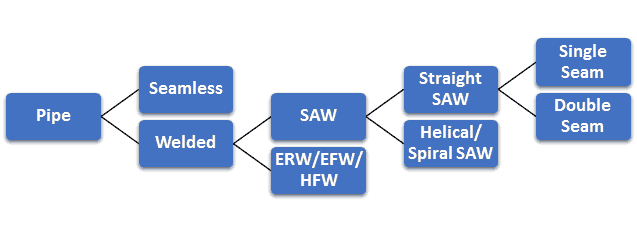Pipe Guide
To fully understand pipe class and piping specification you must know the basics of the piping.
Pipe covers a very large part of any process plant. If you look at the Oil Exploration platform, Refinery and Petrochemical complex one thing that catches the attention is a complex network of piping. Piping is used to transport various process materials from one equipment to another. But why?
Process Plant is a place where a series of activities are performed in particular ordered to convert raw material into a useful product. Interconnected pipe and pipe components are used to transport raw material, intermediated product and final product to the desired location
What is Pipe?
The pipe is a straight pressure-tight cylindrical hollow, used in the piping system to transport liquid, gas, and sometimes solids.
Classification of Pipes (Types of Pipe Used in Oil and Gas)
Different types of pipes used in various design conditions, considering technical and commercial parameters. For small & medium sizes requirement, seamless pipes are more popular whereas, for larger diameter, welded pipes are more economical.
Based on the way pipe manufacturing, Pipes are mainly classified into two categories seamless and welded. Welded pipes are further classified based on the method of welding. There are two ways to weld pipe 1st is with filler metal and 2nd is without filler metal.
Submerged Arc Welding process is with filler metal welding whereas ERW/EFW and HFW are no filler welding methods to weld the pipe. SAW pipes are further classified as straight seam and spiral seam pipe. Straight seam pipes are also known as L-SAW or long seam SAW pipes. Medium diameter straight SAW pipe has a single seam whereas a large diameter pipe has a two-weld seam.
Check the image below for easy understanding.
What is Pipe Class?
Piping class or Pipe Class is a document that specifies the type of the components such as a type of pipe, schedule, material, flange ratings, branch types, valve types and valve trim material, gasket, and all the other components specific requirements to be used for different fluids under different operating conditions in a plant.
Pipe class is developed considering Operating Pressure, temperature, and corrosive environment. Different material specifications are segregated in separate “Piping Class”. Pipe class is part of the Piping specification.
Shortcode is used to cover all the information applicable to the given pipe class. This pipe class is also included in the line number so that field construction engineer can easily identify the material required.
href="tel: +91 2266151881" class="call"
Check the link for the example of a piping class specification.
You can watch this video, where I have explained the above Pipe class in great detail.
What is the piping Specifications?
Piping Specifications are technical documents that are generated by private companies to address additional requirements applicable to a specific product or application.
Piping Specs provides specific/additional requirements for the materials, components, or services that are beyond the code and standard requirements. For Example, if you want A106 Gr B pipe with Maximum carbon of 0.23% against standard requirements of 0.3% Max, you must be specified this requirement in your purchase specification.
Why did Specification require?
- It allows a purchaser to include special requirements as per design and service conditions.
- It also allows customization of the product.
- Please note requirement in the specification is Must meet requirements.
Normally, oil & gas facilities generate their own specification during the FEED stage that is front-end engineering and design or sometimes uses readily available specifications from well-established companies such as Shell, Bechtel, EIL, and chevron.
What is Piping Components?
Piping Components are mechanical elements suitable for joining or assembling into a pressure-tight fluid containing piping system. Components include pipes, tubes, fittings, flanges, gaskets, bolt-nuts, valves, expansion joints, hose pipes, traps, strainers, separators, control valves, safety valves, blind flanges, spectacle blinds, and drip rings, etc.
What is the Piping System?
Piping System can define as when piping components are joined together to perform some specific activities such as convey, distribute, mix, separate, discharge, meter, control, or stop the fluid flows is known as a piping system.
If you want to become an expert in piping components you can buy my full course that covers all details related to piping components.
Pipe Dimension
Pipe dimensions are given in size and schedule numbers. Three different terms are commonly used to define the size of the pipes.
- NPS – Nominal Pipe Size
- NB – Nominal Bore
- DN – Diameter Nominal
You can check the complete guide on Pipe Size and Schedule (Click on the link) for in-depth understanding.
Dimensions of the pipes are covered in following Standard
- ASME B36.10 – Welded and Seamless Wrought Steel Pipe (Carbon & Alloy Steel)
- ASME B36.19 – Stainless Steel Pipe
What is Small Bore Pipe and Large Bore Pipe?
In the project, you will come across the terms such as small Bore & big bore or large bore pipe.
Small Bore Pipe
Pipe Size up to 2” are considered small bore pipe. However, some companies considered up to 2.5″ pipe as a small-bore.
Large Bore Pipe (Big Bore Pipe)
Pipe Size above 2″ are considered large bore or big bore pipe
Pipe Length
The length of the pipe is mentioned in either meter or feet. During production, pipes are not manufactured in the same lengths, and during the construction of the process plants, you required various lengths of pipes. To address this issue standard has defined pipe lengths in single random and double random categories.
Single random pipes
Single random pipes come in 4
Double random pipes
Double random pipes have a minimum average length of 10.7 m and a minimum length of 4.8 m with 5 % of lengths in between 4.8 m to 10.7 m
Pipe End Types
The pipes come in following end types;
- Plain Ends
- Beveled Ends
- Threaded Ends
- Socket & Spigot Ends
Flanged Ends- Buttress Ends


